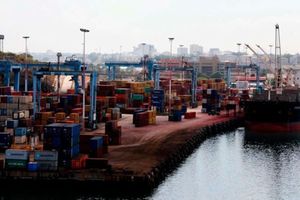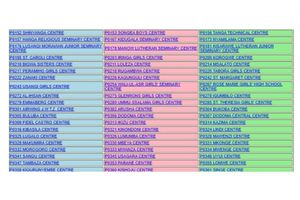How Tanzania plans to curb cooking oil shortages

What you need to know:
- The East African second largest economy is seeking to liberate its edible oil sub-sector by increasing local production to end imports
Mtwara. Currently, Tanzania produces only 205,000 tonnes of cooking oil a year, which is not enough to meet its annual demand of 570,000 tonnes. The country is thus compelled to spend over Sh443 billion annually to import 365,000 tonnes of edible oil to cover the shortage.
Meanwhile, the government has been making efforts to ensure domestic oil production increases substantially.
To that end, farmers of the requisite raw materials have been called upon to apply correct technologies and good farming practices as advised by agricultural experts so that they would eventually boost their production.
Tanzania Agricultural Research Institute (Tari) director general Geofrey Mkamilo says the current situation, which has been ongoing for long, is unaccep
table. This is why the government through the Agriculture ministry has laid down strategies designed to ensure that cooking oil is produced locally to at least meet the domestic demand.
Dr Mkamilo says Tanzania produces various types of crops suitable for producing raw materials for the manufacture of edible oil, including palm, sunflower, groundnuts and cotton. All these are part of the Institute’s strategy for bolstering cooking oil production locally.
“Ask yourself: why do we produce so little edible oil? Indeed, the major problem here is productivity. For example, a peasant farming an acre of palm can produce 1.6 tonnes of oil, while a sunflower farmer produces very much less: less tha one tonne of oil per hectare!
“The sunflower grower could have produced 2.5 tonnes of oil had he engaged in cultivating palms on the same acreage,” he marvelled.

The coordinator of sunflower crop from Tanzania Agricultural Research Institute, Mr Frank Rueben, displays seeds of the crop. Tanzania grows a number of crops that have huge potential of producing sufficient edible oil to meet the country’s annual demand. However, currently the country produces only a third of its needs. PHOTO | FLORENCE SANAWA
“A sesame farmer can produce 0.25-to-0.5 tonnes of oil per hectare. But, sesame that is grown in Lindi Region can produce 1.0-to-1.5 tonnes of the same cooking oil!
“A grower has to get better seeds for these crops, as it is the only sure-fire way to increase productivity of the raw materials for processing in our edible oil industries.
“We projected to produce 35 tonnes of better sesame seeds this year so that growers can easily access them at our Nachingwea Centre.
“This will give us assurance that such centres continue to contribute to the availability of cooking oil in the country, even as we continue to mobilise growers to use the hybrid tenera palm seeds that can produce five tonnes of oil per hectare compared to other palm seeds that currently produce only 1.6 tonnes of oil,” Dr Mkamilo says.
“We are also planning to produce better sunflower seeds largely grown in Dodoma and Singida regions so that farmers can also have ready access to them.
“This is the only way of obtaining quality raw materials for edible oil production - and also the only way of fixing the problem of acute shortages of cooking oil in Tanzania,” he said.
The Agriculture ministry seeks to ensure that the Tari study results reach many stakeholders, thereby increasing employment opportunities while doing away with having to spend the scarce, hard-earned foreign exchange on edible oil importation.

A sesame grower inspects the flowers of the crop in her farm. Tanzania is strategising on ensuring that it uses its oil producing crops to meet its annual edible oil needs through improved production both in the farm and industries. PHOTO|FILE
Dr Mkamilo says at least 78 percent of the Tanzanian sesame oil is produced in Lindi and Mtwara regions. If only for this reason, Tari is out to ensure that farmers in those areas get better seeds for increased productivity and production.
For his part, Tari Naliendele Centre’s director Fortunus Kapinga says Tari’s major reputation is to produce white sesame that fetches a good price in the world market.
He says their main target has been the Lindi 2002 seed product that is resilient against diseases and harmful insects. Also, it matures quickly – and its growers have branded it Lindi white because of its white colour. It has a good market, and many growers are benefiting from it – and they have stopped using the old kind of seeds.
The coordinator of the National Oil Seed Research Programme at the Tari Naliendele Centre, Mr Joseph Nzunda, says their seed research programme has made great achievements in and outside the country in terms of sesame and groundnut.
He says in the five-year period of the programme, they have managed to discover two types of better seeds –namely Lindi 2002 and Ziada 94 – that are grown more by farmers.
According to Nzunda, there are 13 types of sesame seeds researched by the centre. The seeds include Morada; Improved Morada; Morada-2; Lindi white; SSBS 7; SSBS 4; Bora; Naliendele 92; Ziada 94; Lindi 2002; Mtwara 2009 and Mtondo 13.
He says six out of 17 better seeds of groundnut were discovered within the five-year period of the research.
The discovered seeds include Kuchele 2015; Nachi 2015; Narinut 2015; Naliendele 2016; Mtwaranut 2016 and Tanzanut 2016.
Also, he says, there has been an increase in the production of better seeds of sesame from a minimum of five tonnes to a maximum of 34 tonnes for the year 2019/2020 and a rise in reproduction of better seeds of groundnuts from a minimum of three tonnes to a maximum of 15 tonnes for the year 2019/2020.
So far, they have managed to distribute better seeds and technology to a good number of growers in the 11 administrative regions of Katavi, Ruvuma, Mbeya, Songwe, Lindi, Mtwara, Manyara, Pwani (Kibiti), Dodoma (Bahihi), Tanga and Morogoro.
Previously, such a service was provided only to Lindi, Mtwara, Singida and Tabora regions.
“We managed to make exhibitions through demos in the Lake, Eastern and Southern Zones, whereby we reached farmers in 12 regions including Mtwara, Lindi, Ruvuma, Njombe, Songwe, Mbeya, Tabora, Geita, Shinyanga, Dodoma, Singida and Simiyu,” he says.
In the provision of services for groundnut farming, at least 22 administrative districts were reached, including Mtwara, Masasi, Nanyumbu, Tunduru, Namtumbo, Nachingwea, Lindi, Mbozi, Mrali, Wanging’ombe and Sikonge.
The other districts are Nzega, Kaliua, Urambo, Igunga, Kahama, Bukombe, Itilima, Maswa, Chamwino, Bahi and Singida Rural.
All in all, a total of 530 groups of farmers were reached throughout the country.
According to Mr Nzunda, the research into better seeds has placed Tanzania among the top ten countries in the world known for their reproduction of sesame and groundnut seeds – seeds which meet the world market requirements in terms the amount of cholesterol and ingredients, as well as of colour.





